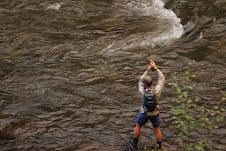
One place that the temperature has been very stable is in our school's new Salmon Incubation Tank. Yes, we set up the tank on the 13th and 14th in preparation for the arrival of 500 Coho salmon eggs. I had four students, two high schoolers and two middle schoolers help set up the filtration system, cooling system, add the water, and insulate the outside of the tank. Then on Tuesday evening, we received our shipment of salmon eggs. Again, students helped to safely transfer the eggs from their chilled shipping environment to the tank water, which had been chilled to approximately 8 degrees C. (46.4 degrees F.) When I checked the eggs the next morning, there was only one casualty. I safely removed the dead egg with a turkey baster, and since then, all the eggs look viable.

My students then had to calculate the estimated time the "eyed" eggs would hatch. I wanted them to hatch close to our departure for Christmas break, so that we wouldn't have to worry about maintenance of the tank while we were gone. The egg development depends mostly on the temperature that we keep the water. Students have been measuring the water temperature everyday and calculating the ATUs (Accumulated Thermal Units). Coho salmon eggs hatch usually around 450 - 500 ATUs. Today, we calculated that the eggs have 371.5 ATUs at this time. We lowered the temperature of our tank to 7 degrees C. (44.6 degrees F.) so that the eggs would hatch around Dec. 11 - 13 and we would have enough time to do the 3 - 4 water changes necessary to maintain good water quality. During this time, we will lower the temperature of the tank down to 4 - 5 degrees C. in order to lower the biological activity.
While we are on Christmas break, the Alevin will be hiding deep in the rocks of the tank, slowly absorbing their gigantic yolk sacs. When they finally "button up", they will emerge from the rocks again and be free swimm
 ing salmon fry.
ing salmon fry.Overall, the students are pretty excited about the project. I usually don't have to ask for volunteers to help with maintenance and data recording for the tank. It actually presents another factor of classroom management that I have to deal with. Students love to just sit there and watch the "Salmon TV."
So stayed tuned for updates on Eek School's Salmon Incubation Project.
Thanks for reading!
Dirk







1 comment:
That's awesome, Dirk! You got a good science program happening in Eek. Well done!
Post a Comment